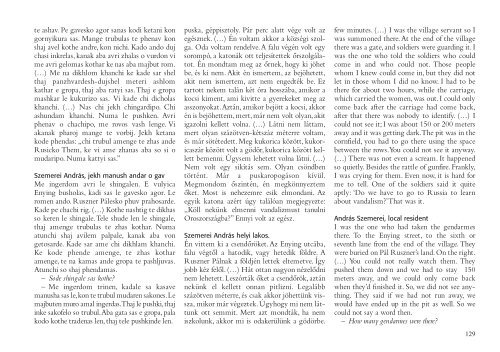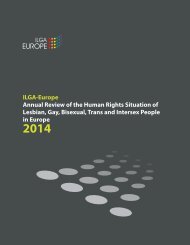Create successful ePaper yourself
Turn your PDF publications into a flip-book with our unique Google optimized e-Paper software.
te ashav. Pe ga ves ko agor sanas kodi ketani kon<br />
gornyikura sas. Mange trubulas te phenav kon<br />
shaj avel kothe andre, kon nichi. Kado ando duj<br />
chasi inkrelas, kanak aba avri zhalas o vurdon vi<br />
me avri gelomas kothar ke nas aba majbut rom.<br />
(…) Me na dikhlom khanchi ke kade sar shel<br />
thaj panzhvardesh-dujshel meteri ashlom<br />
kathar e gropa, thaj aba ratyi sas. Thaj e gropa<br />
mashkar le kukurizo sas. Vi kade chi dicholas<br />
khanchi. (…) Nas chi jekh chingardipo. Chi<br />
ashundam khanchi. Numa le pushken. Avri<br />
phenav o chachipo, me rovos vash lenge. Vi<br />
akanak pha roj mange te vorbij. Jekh ketana<br />
kode phendas: „chi trubul amenge te zhas ande<br />
Rusicko Them, ke vi ame zhanas aba so si o<br />
mudaripo. Numa kattyi sas.”<br />
Szemerei András, jekh manush andar o gav<br />
Me ingerdom avri le shingalen. E vulyica<br />
Enying busholas, kadi sas le gavesko agor. Le<br />
romen ando. Ruszner Pálesko phuv praho sarde.<br />
Kade pe chachi rig. (…) Kothe nashtig te dikhas<br />
so keren le shingale. Tele shude len le shingale,<br />
thaj amenge trubulas te zhas kothar. Numa<br />
atunchi shaj avilem palpale, kanak aba von<br />
getosarde. Kade sar ame chi dikhlam khanchi.<br />
Ke kode phende amenge, te zhas ko thar<br />
amenge, te na kamas ande gropa te pash l juvas.<br />
Atunchi so shaj phendamas.<br />
– Sode shingale sas kothe?<br />
– Me ingerdom trinen, kadale sa kasave<br />
manusha sas le, kon te trubul mudaren sakones. Le<br />
majbuten muro amal ingerdas. Thaj le pushki, thaj<br />
inke sakofelo so trubul. Aba gata sas e gropa, pala<br />
kodo kothe tradenas len, thaj tele pushkinde len.<br />
puska, géppisztoly. Pár perc alatt vége volt az<br />
egésznek. (…) Én voltam akkor a községi szolga.<br />
Oda voltam rendelve. A falu végén volt egy<br />
sorompó, a katonák ott teljesítettek ôrszolgálatot.<br />
Én mondtam meg az ôrnek, hogy ki jöhet<br />
be, és ki nem. Akit én ismertem, az bejöhetett,<br />
akit nem ismertem, azt nem engedték be. Ez<br />
tartott nekem talán két óra hosszába, amikor a<br />
kocsi kiment, ami kivitte a gyerekeket meg az<br />
asszonyokat. Aztán, amikor bejött a kocsi, akkor<br />
én is bejöhettem, mert, már nem volt olyan, akit<br />
igazolni kellett volna. (…) Látni nem láttam,<br />
mert olyan százötven-kétszáz méterre voltam,<br />
és már sötétedett. Meg kukorica között, kukoricaszár<br />
között volt a gödör, kukorica között kellett<br />
bemenni. Úgysem lehetett volna látni. (…)<br />
Nem volt egy sikítás sem. Olyan csöndben<br />
történt. Már a puskaropogáson kívül.<br />
Megmondom ôszintén, én megkönnyeztem<br />
ôket. Most is nehezemre esik elmondani. Az<br />
egyik katona azért úgy találóan megjegyezte:<br />
„Köll nekünk elmenni vandalizmust tanulni<br />
Oroszországba?” Ennyi volt az egész.<br />
Szemerei András helyi lakos.<br />
Én vittem ki a csendôröket. Az Enying utcába,<br />
falu végtôl a hatodik, vagy hetedik földre. A<br />
Ruszner Pálnak a földjén lettek eltemetve. Így<br />
jobb kéz felôl. (…) Hát ottan nagyon nézelôdni<br />
nem lehetett. Leszórták ôket a csendôrök, aztán<br />
nekünk el kellett onnan pitlizni. Legalább<br />
százötven méterre, és csak akkor jöhettünk vissza,<br />
mikor már végeztek. Úgyhogy mi nem láttunk<br />
ott semmit. Mert azt mondták, ha nem<br />
iszkolunk, akkor mi is odakerülünk a gödörbe.<br />
few minutes. (…) I was the village servant so I<br />
was summoned there. At the end of the village<br />
there was a gate, and soldiers were guarding it. I<br />
was the one who told the soldiers who could<br />
come in and who could not. Those people<br />
whom I knew could come in, but they did not<br />
let in those whom I did no know. I had to be<br />
there for about two hours, while the carriage,<br />
which carried the women, was out. I could only<br />
come back after the carriage had come back,<br />
after that there was nobody to identify. (…) I<br />
could not see it; I was about 150 or 200 meters<br />
away and it was getting dark. The pit was in the<br />
cornfield, you had to go there using the space<br />
between the rows. You could not see it anyway.<br />
(…) There was not even a scream. It happened<br />
so quietly. Besides the rattle of gunfire. Frankly,<br />
I was crying for them. Even now, it is hard for<br />
me to tell. One of the soldiers said it quite<br />
aptly: ‘Do we have to go to Russia to learn<br />
about vandalism?’ That was it.<br />
András Szemerei, local resident<br />
I was the one who had taken the gendarmes<br />
there. To the Enying street, to the sixth or<br />
seventh lane from the end of the village. They<br />
were buried on Pál Ruszner’s land. On the right.<br />
(…) You could not really watch them. They<br />
pushed them down and we had to stay 150<br />
meters away, and we could only come back<br />
when they’d finished it. So, we did not see anything.<br />
They said if we had not run away, we<br />
would have ended up in the pit as well. So we<br />
could not say a word then.<br />
– How many gendarmes were there?<br />
129



